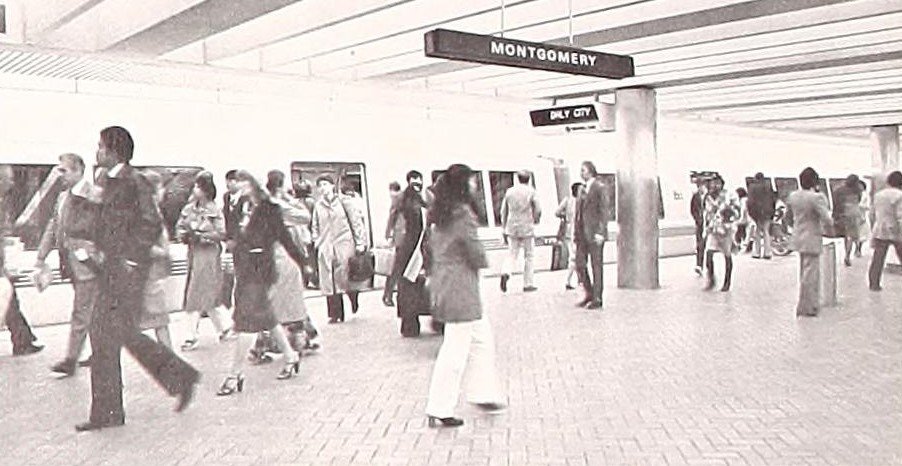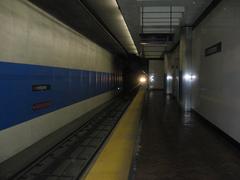
Montgomery Street Station: Visiting Hours, Tickets, and Guide to San Francisco Historical Sites
Date: 14/06/2025
Introduction: History and Significance
Montgomery Street Station is a cornerstone of San Francisco’s Financial District, representing both a vital transit hub and a gateway to the city’s storied past. Opened in 1973 as part of the Bay Area Rapid Transit (BART) Market Street subway, the station sits at the heart of a neighborhood once defined by Gold Rush-era wharves and now by iconic skyscrapers. Its strategic location connects daily commuters and visitors to landmarks such as the Transamerica Pyramid, Union Square, Chinatown, and the Ferry Building Marketplace. The station weaves together San Francisco’s architectural evolution, economic rise, and ongoing urban revitalization, making it a fitting starting point for exploring the city’s historical and cultural riches (BART Historical Timeline; Wikipedia: Montgomery Street Station).
This guide details Montgomery Street Station’s visiting hours, ticketing options, accessibility, and nearby attractions. It also offers travel tips and insights into the station’s architectural highlights, making it a valuable resource for first-time tourists, daily commuters, and history enthusiasts alike.
Table of Contents
- Early History of Montgomery Street and Its Surroundings
- The Rise of the Financial District
- Planning, Construction, and Opening of Montgomery Street Station
- Architectural Features and Upgrades
- Visiting Hours, Tickets, and Accessibility
- Nearby Attractions and Travel Tips
- Events and Community Life
- Practical Visitor Tips
- Frequently Asked Questions (FAQ)
- Conclusion and Resources
Early History of Montgomery Street and Its Surroundings
Montgomery Street’s origins reflect the dramatic transformation of San Francisco. In the 1830s, this area marked the edge of the bay, frequented by wildlife and fishermen (Wikipedia: Montgomery Street). The Gold Rush of 1848–1855 spurred rapid development—land was reclaimed from the bay, and Montgomery Street quickly became central to the burgeoning city. Today, the street lies several blocks inland from the current waterfront, a testament to this era of change.
A pivotal moment in California’s history occurred at Montgomery and Clay Streets, where John B. Montgomery raised the U.S. flag in 1846, marking the transition of California from Mexican to American control (Wikipedia: Montgomery Street). The Admission Day Monument at Montgomery and Market commemorates California’s 1850 entry into the Union.
The Rise of the Financial District
By the late 19th century, Montgomery Street emerged as the “Wall Street of the West.” The construction of the Montgomery Block in 1853 (on today’s Transamerica Pyramid site) anchored the district as a center for law, finance, and commerce. Over the decades, the street filled with banks and investment firms, shaping the skyline and the city’s economic future. Today, the Financial District boasts a dense concentration of high-rise office towers and is home to landmarks like One Montgomery Tower and 44 Montgomery, both linked to the station (Wikipedia: Montgomery Street; Wikipedia: Montgomery Street Station).
Planning, Construction, and Opening of Montgomery Street Station
The vision for Bay Area rapid transit emerged in the 1940s to address mounting congestion. After legislative approval and a successful bond measure in 1962, construction of the Market Street subway—home to Montgomery Street Station—began in 1967 (BART Historical Timeline). The station was named in 1965 and opened for BART service on November 5, 1973, quickly becoming one of the busiest stops in the system (Wikipedia: Montgomery Street Station). Muni Metro service was added in 1980, enhancing the station’s role as a multimodal transit interchange (Wikipedia: Montgomery Street Station).
Architectural Features and Upgrades
Montgomery Street Station is a three-level underground structure:
- Mezzanine: Separate paid areas for BART and Muni, with domed hexagonal “bubble tiles.”
- Second Level: Island platform for Muni Metro.
- Third Level: BART island platform.
The station is accessible via seven street entrances, with direct underground connections to major buildings like One Sansome and 44 Montgomery (Wikipedia: Montgomery Street Station). Skidmore, Owings & Merrill’s design prioritizes durability and high passenger flow.
Upgrades have included enhanced lighting, signage, and accessibility features. Following security concerns post-9/11, restrooms were closed and only recently reopened after major renovations. A multi-year project to add protective canopies to entrances began in 2021 and is set for completion in 2027 (Wikipedia: Montgomery Street Station; BART News).
Visiting Hours, Tickets, and Accessibility
- Hours: Generally open from 5:00 AM to midnight daily for BART; Muni Metro hours are similar. Night bus service extends transit options during off-hours (San Francisco Subway).
- Tickets: Use Clipper cards for contactless payment across BART and Muni. Fares vary by distance for BART and are flat-rate for Muni. Purchase at ticket vending machines or service booths within the station (BART Fares; SFMTA Fares).
- Accessibility: The station is ADA-compliant—elevators, escalators, tactile paving, audible announcements, and multilingual signage are provided.
Nearby Attractions and Travel Tips
Montgomery Street Station puts you within walking distance of:
- Transamerica Pyramid: Iconic skyscraper undergoing transformation and public park additions (Shvo Press).
- Union Square: Major shopping, dining, and theater district (SFTourismTips).
- Yerba Buena Gardens: Public art, green space, and the Martin Luther King, Jr. Memorial (SFTravel).
- San Francisco Museum of Modern Art (SFMOMA): A leading contemporary art museum (SFTravel).
- Wells Fargo History Museum: Exhibits on the American West’s financial history.
- Ferry Building Marketplace: Local food and artisan goods at a historic waterfront terminal.
- Chinatown Gate: Entrance to one of the oldest and most vibrant Chinatowns in North America.
For a scenic ride, board the California Street Cable Car, or explore the Embarcadero and Waterfront for views of the Bay Bridge and access to the Exploratorium (SFTravel).
Events and Community Life
Montgomery Street Station is a hub for major citywide events, including:
- Frameline Film Festival: LGBTQ+ cinema in June (SFStation).
- Yerba Buena Gardens Festival: Outdoor concerts and performances (SFStation).
- North Beach Festival: Celebrating Italian heritage (SFStation).
- Juneteenth Festival: Cultural celebration nearby (SFTourismTips).
- Illuminate SF Festival of Light: Winter light installations (SFTravel).
The station’s design and multiple entrances ensure efficient crowd management during large events.
Practical Visitor Tips
- Transit Connections: Transfer easily to city buses or BART lines for other neighborhoods. The #38 Geary bus offers a direct route to Japantown and the Cherry Blossom Festival (GoTravelDaily).
- Safety: The area is generally safe; remain alert, especially at night. Security is provided by BART Police and SFMTA staff.
- Restrooms: Restrooms are available at the station and at nearby attractions like the Ferry Building.
- Photography: Capture the station’s architecture and surrounding cityscapes, especially during city events or rush hour.
- COVID-19 Protocols: Check current health and safety guidelines on the BART website.
Frequently Asked Questions (FAQ)
Q: What are Montgomery Street Station’s visiting hours?
A: Open daily, typically from 5:00 AM to midnight. Confirm current hours on the BART website.
Q: How do I buy tickets?
A: Purchase from vending machines at the station or use a Clipper card; separate fares for BART and Muni apply.
Q: Is the station accessible?
A: Yes, it is fully ADA-compliant with elevators, tactile paving, and multilingual signage.
Q: Are guided tours available?
A: While the station does not offer tours, many walking tours of the Financial District and nearby landmarks depart close by.
Q: Where can I find restrooms?
A: Renovated restrooms are available at the station; additional facilities are nearby (e.g., Ferry Building).
Conclusion
Montgomery Street Station stands as both a modern transit hub and an entry point to San Francisco’s rich history, culture, and architecture. With its accessible design, convenient location, and proximity to museums, parks, shopping, and historic neighborhoods, the station is an ideal starting place for any city adventure. Stay updated on schedules, fares, and events by visiting the BART website and the SFMTA. Download the Audiala app for audio-guided tours and real-time transit information, and follow local tourism channels for the latest updates and insider tips.
References
- Wikipedia: Montgomery Street Station
- BART Historical Timeline (PDF)
- San Francisco Subway
- Shvo Press
- SF Travel
- SFTourismTips
- SFStation
- GoTravelDaily
- BART News
- BART Fares
- SFMTA Fares






































































































































































